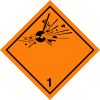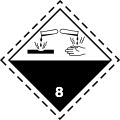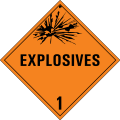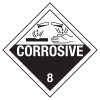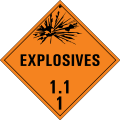Buildings
A placard is posted on buildings to communicate a wide variety of information, such as fire safety policies, emergency shelters.
The International Building Code requires doors in some public and commercial structures, fitted with an internal key lock have a notice "This door to remain unlocked when this space is occupied" in a minimum of 1 inch (25 mm) text be posted beside or above the door. [2] Some state and local building codes modify this text, such as California fire code, which specifies "This door to remain unlocked during business hours". [3]
Temporary placards may be placed on buildings such as warning signs when a structure is being fumigated, or has been condemned by building inspectors or the fire department and is unsafe to enter.
Fallout shelters

As part of the civil defense preparations in the event of a nuclear attack, in 1961 United States began establishing fallout shelters in communities across the country. The shelters were symbolized by orange-yellow and black trefoil symbol, designed by Robert W. Blakeley. [4]
In 1962, 1.4 million metal signs and 1 million adhesive stickers were manufactured and distributed across the country at a total cost of $700,500 equivalent to $7,281,655in 2024. [5] Two standard signs were used widely, a 14 by 20 inches (360 by 510 mm) aluminum sign for posting on the exterior of buildings identifying the building as having a fallout shelter, and a 10 by 14 inches (250 by 360 mm) steel sign, intended for interior use to the shelter's location and mark the actual location of the shelter within the building. [6]
The sign system included "overlays" that were designed to be added to signs for conveying additional information about the specific shelter and its location. [7]
Exterior sign overlays:
- Numbers - for Capacity marking
- Arrows
- In Basement
- Refugio - (Spanish speaking areas)
- Refugio Contra Radiacion - (Spanish speaking areas)
- Lafiga Mai Pefuatomika - (American Samoa)
- Aofai E Ofi - (American Samoa)
- Miles
- Blocks
- Numbers for "Miles" & "Blocks"
Interior sign overlays:
- Starts Here - With arrows
- Capacity - with numbers
- Comienzo - with arrows (Spanish speaking areas)
- Amata Iinei - with arrows (American Samoa)
- In This Corridor
- On
- Floors
- Numbers for the "Floors"
Alternate languages overlays in Spanish in areas where it was widely spoken and Samoan for use on American Samoa. [7]
Following the ending of funding for fallout shelters in the late 1970s. Following the end of the program there was no organized effort by the federal government reclaim shelter supplies and signage, resulting in most shelters being abandoned in situ until building owners cleared away the shelter's supplies and signage during subsequent renovations or demolition projects. [8] In 2017, New York City announced a formal project to go through all city-owned structures and remove any remaining fallout shelter signage, citing the fact no structure still had a functioning shelter and would not be usable in an emergency. [8]
Firefighting markings
Numerous markings have been developed to better aid firefighters and other first responders to warn of hazards from hazardous materials, location of utility shut-offs, fire alarm and sprinkler control panels, construction and condition of the building.
Fire sprinkler systems
The International Code Council's International Building Code requires that all fire standpipe and fire sprinkler connections must be visible from the roadway or fire department access in new construction. On existing buildings, where the connection is not visible from these places, it must clearly marked with a red and white sign, with "FDC", short for "Fire Department Connection", in 6 inches (150 mm) letters, with any other lettering or arrows being 2 inches (51 mm) tall. [2] Signs must also state what is fed by the connection. If a connection does not cover an entire building, such a connection feeding fire sprinklers that are only in a new addition, the area covered must be stated on the sign.
If a fire alarm system does not automatically call the fire department, a "When Alarm Sounds - Call Fire Department" sign must be posted at all fire alarm pull station/call points and at any external fire alarm notification appliances.
NFPA 704

NFPA 704 is a standard developed by the National Fire Protection Association for warning first responders to hazards posed by hazardous materials stored in a building or facility. The signs are intended to be mounted on the exteriors of buildings, storage tanks and storage areas.
The square is divided into four sections, color coded: Red - flammability; blue - health hazard; yellow - reactivity/instability; White - special hazard, such as oxidizers, water reactive or Asphyxiating gas.
The red, yellow and blue sections are labeled on scale of 0 to 4; 0 "minimal hazard" to 4, "severe hazard". White (special hazard) is represented by letter codes ("OX","SA", a "W" with a line through it).
NFPA 170
Introduced in 1991, NFPA 710 combined 4 existing standards, 171, 172, 174 and 178 into a single standard NFPA 710 - Fire Safety and Emergency Symbols. The standard contains symbols for use in buildings to locate exits, firefighting equipment and enforce fire safety rules, in addition to symbols for building blueprints, diagrams and firefighting operation maps. [9]
The standard utilizes the ISO's "running man" symbol for exit signage, similar to international standards, along with the ISO 7010 symbols for Fire alarm call point, fire extinguisher and fire hose reel. [a] [9] The standard also provides symbols for marking standpipe connectors and identifying what the standpipe connection supplies water to: fire sprinkler systems, standpipes or both.
The standard also contains symbols for informing for enforcing fire safety rules, such as prohibiting cooking, smoking, hanging of items from fire sprinklers, and use of elevators in evacuations. [9]
Truss/floor construction
Changes in building design, towards "lightweight construction" [b] in the late 20th century has presented new hazards to firefighters. The materials are prone to failure when exposed to flames, resulting in roof and floor collapses, spread of fire due to heat conduction in designs using metal. [10] The placard's design varies from state to state, though numerous designs use triangles. All systems use the basic labeling system: "F" for "floor", "R" for "roof" and "RF" for "floor and roof". New York's system also includes information on the material trusses are constructed from. [11] The states of Florida, [12] New Jersey, [13] New York, [11] Vermont, [14] and Mississippi; [15] along with the cities of San Francisco, CA, [16] Chesapeake, VA [17] and Acushnet, MA [17] have laws requiring posting of a truss warning placard on structures.
Vacant Building markings
On 3 December 1999, six firefighters died fighting a fire inside an abandoned six floor warehouse. The firefighters had entered the structure and became disoriented and unable to escape the maze-like interior before multiple collapses occurred. Following the disaster, the National Institute for Occupational Safety and Health recommended:
Recommendation #10: Fire departments should identify dangerous vacant buildings by affixing warning placards to entrance doorways or other openings where fire fighters may enter. [18]
— Richard W. Braddee
In 2006, the International Code Council's International Fire Code introduced a marking system to help firefighters identify abandoned, vacant or unsafe structures and hazards posed by them. The system was devised from system used by the New York City Fire Department, recommended by NIOSH in the Worcester report, with modifications to color and sign dimensions. [19] [c] The signs are red and white, 24 inches (610 mm) square, mounted on the front and entrances to the structure, with the date it was posted. [20] [21]
- Section 311 - Vacant building placards
- Structure is in normal condition as of the most recent inspection.
- Interior firefighting and rescue operations should be conducted with caution, due to structural hazards.
- Exterior firefighting only, with interior operations only to protect life.
To provide useful information in planning operations, signs can have letter combinations added to identify known hazards. [21] [11]
- R/O - Roof open
- S/M - Stairs, steps and landings missing
- F/E - Avoid fire escapes
- H/F - Holes in floor
- F/O - Floors open




